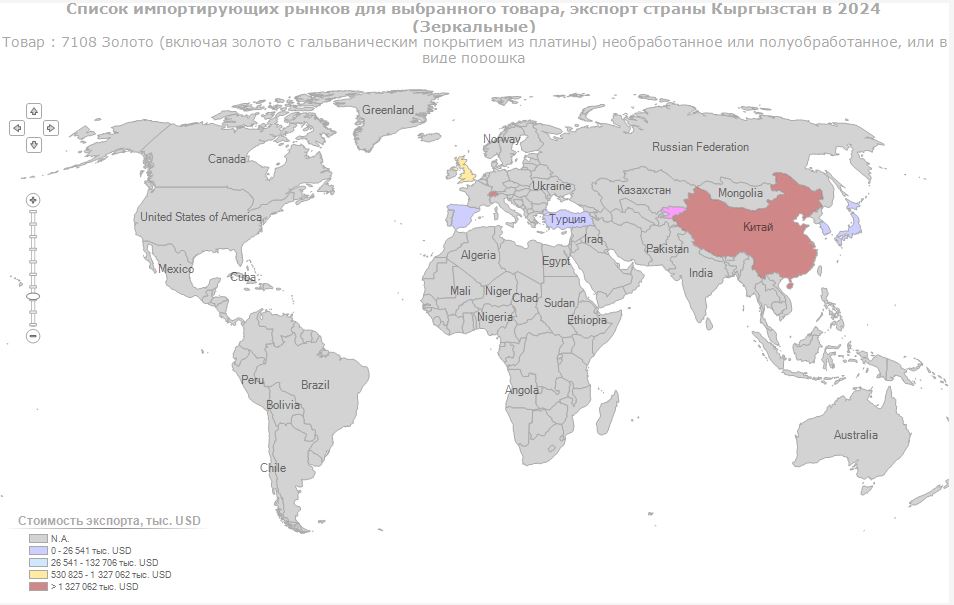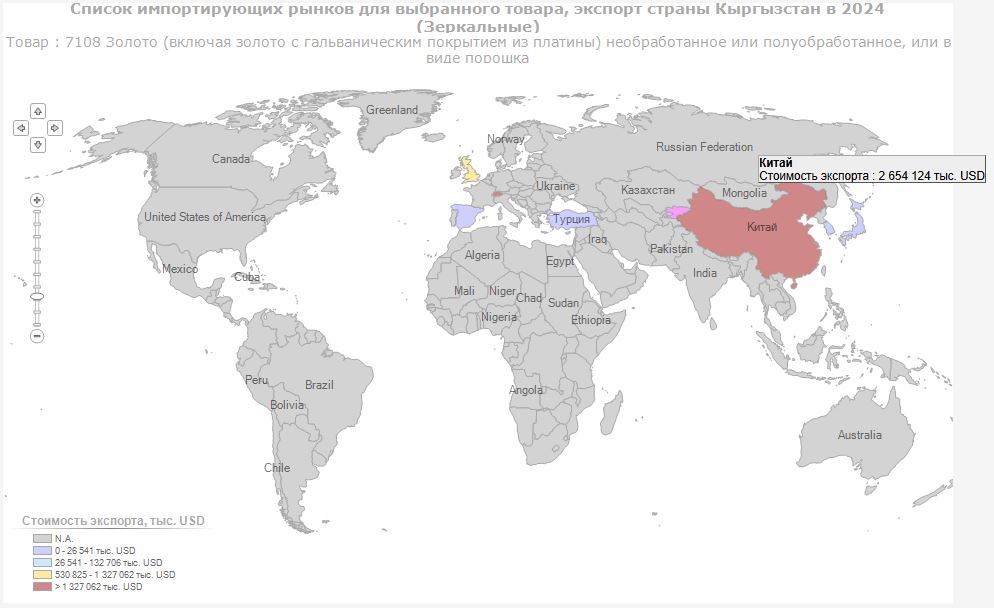
Published
03/26/2025, 09:39According to preliminary data, Kyrgyzstan exported 17.8 tons of gold (HS Code 7108) in 2024, which is 11.88% less than the previous year. This gold, including various types of unprocessed and semi-processed metal, as well as platinum-coated gold, was shipped to several countries. The buyers included the United Kingdom (almost 15 tons), Hong Kong, a special administrative region of China (1.8 tons), Switzerland (971.5 kilograms), and the UAE (13.5 kilograms). These exports brought Kyrgyzstan $1.4 billion.
At first glance, this appears to be ordinary economic statistics. However, when looking at mirror data — the reports of countries importing Kyrgyz gold — the picture changes dramatically.
According to national statistics, Kyrgyz gold exports decreased by 11.88% last year compared to 2023, dropping from 20.2 tons. The main reason for this decline was a sharp reduction in shipments to Switzerland, which was the key gold buyer in 2023. The export volume to this country fell 17.6 times, decreasing from 17.1 tons.
At the same time, the decrease in physical export volumes did not affect total revenue. In 2023, despite a larger amount of gold being shipped abroad, the total revenue was 1.28 billion USD. Thus, the decline in gold export volumes was offset by an increase in its price.
According to the international portal TradeMap, Kyrgyzstan exported not 17.8 tons but a total of 70 tons of gold in 2024. This is twice as much as in 2023 (36 tons) and four times higher than the official national statistics report.
Interestingly, the main buyer was not the United Kingdom, but China, which purchased 30 tons of Kyrgyz gold. Moreover, 26.3 tons of this amount were sent in the fourth quarter, that is, just a few months ago.

At the same time, national statistics lack data on gold shipments to China. However, according to TradeMap, gold exports to this country brought Kyrgyzstan 2.7 billion USD, accounting for nearly 45% of the total revenue from the sale of precious metals abroad (5.9 billion USD). In comparison, official data of the Republic indicates that the income from gold exports is four times lower — only 1.4 billion USD.

Following China, Switzerland is next, to which, according to TradeMap, 23 tons were sent (5 tons more than in 2023). The United Kingdom received 15 tons, and Hong Kong received 2 tons. Only here do the figures match the national reports.



When it comes to trade with China, official data shows that the trade turnover with this country in 2024 amounted to 5.6 billion USD. The overwhelming majority — 5.45 billion USD — was imports from China, while our exports to China are estimated at only 123.6 million USD. However, according to the data from the General Administration of Customs of China, the trade volume between the two countries reached 19.9 billion USD from January to November 2024, and by the end of 2024, it is expected to be 22.1 billion USD.
A small discrepancy in data between countries is usually explained by differences in accounting methodologies. However, the gap in customs data between China and Kyrgyzstan, which is nearly four times, indicates a clear inconsistency.
However, if we return to the shipments of Kyrgyz gold, aside from the fact that its shipments to China are not accounted for in the national statistics, the figures for Switzerland also do not match. Mirror statistics indicate that 23 tons of gold were imported from Kyrgyzstan to Switzerland in 2024, while we report less than a ton — 971.5 kilograms.
The editorial team of "Akchabar" reached out to the National Statistics Committee for clarification. As explained by the committee, gold is divided into two categories within the Eurasian Economic Union (EAEU). The first category is non-monetary gold. This category includes the following commodity positions:
The second category is monetary gold, which pertains to central bank reserves.
"According to the EAEU classification, non-monetary gold is recorded following the accounting methodology in external and mutual trade statistics, while monetary gold is not included in external and mutual trade statistics," — the committee explained.
The agency emphasized that when compiling Kyrgyzstan's external and mutual trade statistics, the National Statistics Committee utilizes all available data sources. The primary sources include information from customs declarations and other documents provided by the Customs Service, as well as official statistical reporting under Form No. 1 — Mutual Trade (monthly) — "Report on Mutual Trade in Goods with EAEU Member States". Additionally, the National Statistics Committee collects and analyzes supplementary data in accordance with the approved accounting methodology.
Moreover, according to the Resolution of the Government of the Kyrgyz Republic No. 470 dated August 20, 2014, "On the Organization and Maintenance of Mutual Trade Statistics with Member States of the Customs Union and External Trade with Third Countries", since the country's accession to the EAEU in 2015, it was established that the Customs Service is responsible for compiling and maintaining statistics on external trade with third countries outside the EAEU. Meanwhile, the National Statistics Committee organizes data collection and compiles statistics on mutual trade in goods with EAEU member states. The same resolution designates the National Statistics Committee as the authorized body responsible for maintaining statistics on external and mutual trade in goods and preparing information on the country's foreign trade turnover.
Considering that the State Customs Service is responsible for external trade statistics, including data on supplies to China, the editorial team of "Akchabar" reached out to the agency with an inquiry regarding the origin of the unaccounted-for 52+ tons of gold. In its response, the agency clarified that the Customs Service compiles customs trade statistics for the Kyrgyz Republic’s external trade with third countries in accordance with the methodology for maintaining customs trade statistics of EAEU member states. According to point 4 of this methodology, the primary source of information for external trade statistics is the data contained in customs declarations.
The State Customs Service also confirmed the National Statistical Committee's statement that, according to points 7 and 8 of the methodology, monetary gold is not included in external trade statistics.
Meanwhile, the State Customs Service emphasizes that the National Statistical Committee relies on state statistical reports and customs data when compiling Kyrgyzstan’s foreign trade statistics. When it comes to the export of monetary gold, the committee exclusively refers to data from the National Bank of the Kyrgyz Republic.
"According to the methodology, exported goods are recorded based on the country of destination, while imported goods are recorded based on the country of origin. This means that when comparing Kyrgyzstan’s gold export data with partner countries’ gold import data, there is a possibility that Kyrgyz gold may appear in their statistics as imported from Kyrgyzstan, while in reality, it was brought in from third countries," — the State Customs Service explains.
The agency also clarified that in 2024, the total volume of gold exports (code 7108 of the EEU Commodity Nomenclature) in unprocessed forms and bars containing at least 995 parts of gold per 1000 parts of alloy (code 7108120001) amounted to 1 billion 342.4 million USD. Of this, 1 billion 212.1 million USD was attributed to supplies to the United Kingdom, 129.4 million USD to Hong Kong, and 900 thousand USD to the UAE.
However, as previously noted, discrepancies in statistics between Kyrgyzstan and China concern not only gold. According to data from the State Customs Service of the Kyrgyz Republic, the mutual trade figures between the Kyrgyz Republic and the People's Republic of China for 2024 are as follows:
According to the State Customs Service of the Kyrgyz Republic:
According to the General Administration of Customs of China (GACC):
It is noted that these figures include vehicles registered under commodity transportation operations with the EEU Commodity Nomenclature codes 8703, 8704, 8709.
Thus, the discrepancy in external trade turnover data between the two countries amounts to 16 billion 885.1 million USD.
"Analysis of mutual trade data between the Kyrgyz Republic and the People's Republic of China for 2024 shows that the main reason for discrepancies is the differences in the methodology for accounting external trade operations. According to the GACC of China, the majority of China's exports to Kyrgyzstan consist of cross-border trade goods, totaling 14.4 billion USD, or 72% of the total volume of Chinese exports. In Kyrgyzstan's customs statistics, cross-border trade is not accounted for," — the State Customs Service explained.
Based on the information provided by the National Statistics Committee and the State Customs Service, it can be concluded that the discrepancy in data regarding more than 52 tons of gold may be attributed to the different methodologies for accounting external trade statistics used in Kyrgyzstan and its partner countries.
Firstly, monetary gold, which pertains to central bank reserves, is not included in external trade statistics. Therefore, its export is not reflected in customs data but may be recorded in the reports of the National Bank.
Secondly, the accounting system for goods varies depending on the country of destination or origin. This means that Kyrgyz gold may have been reflected in the statistics of other countries as imported from Kyrgyzstan, while in reality, it was brought in from third countries.
Thirdly, the significant discrepancy of over 16 billion USD in mutual trade data between Kyrgyzstan and China indicates that a portion of the exports may have gone through cross-border trade, which is not accounted for in Kyrgyz statistics.



